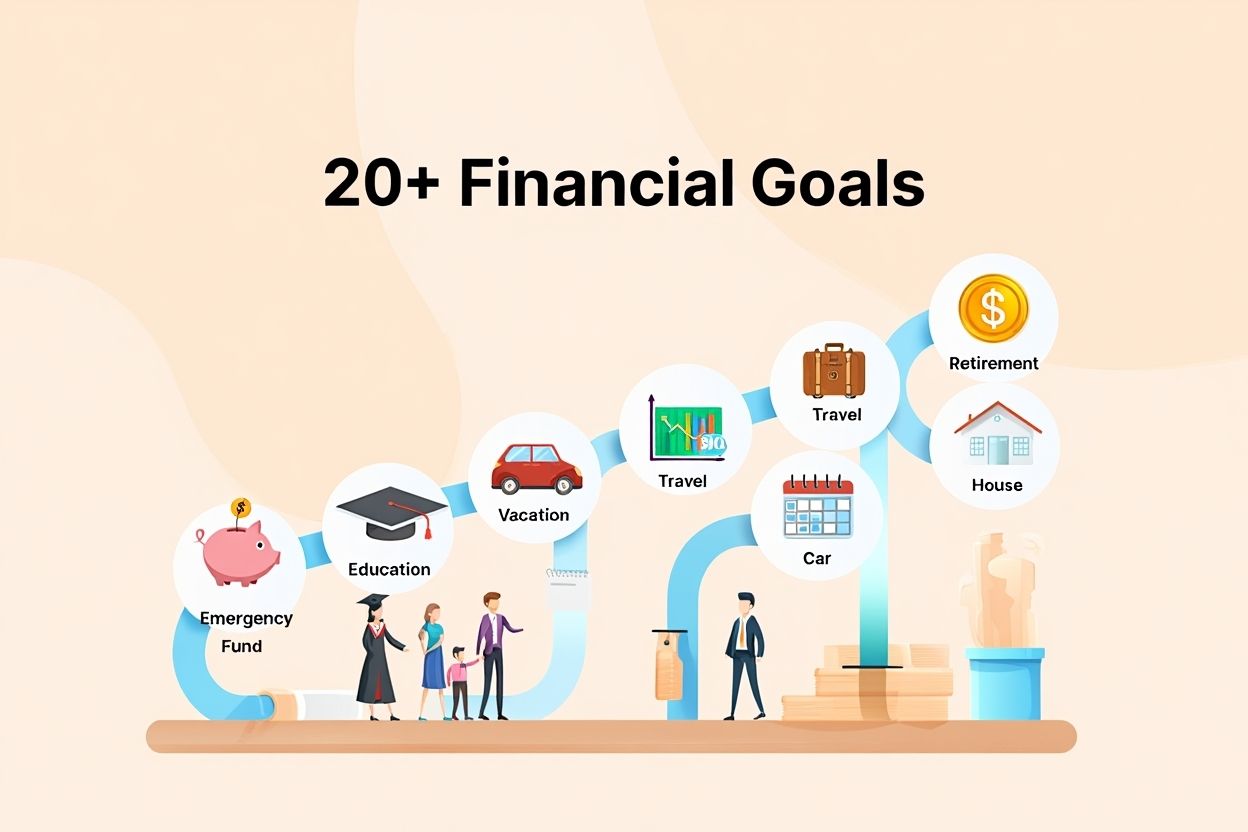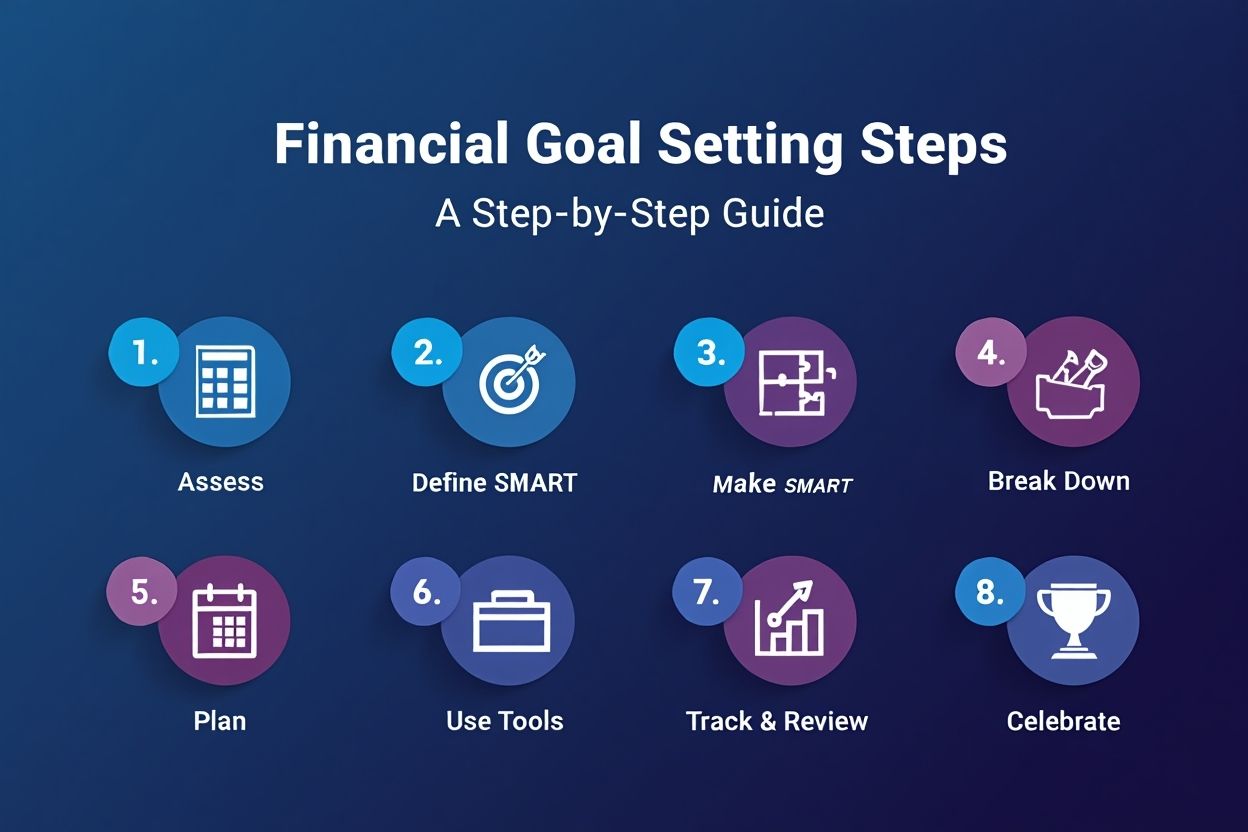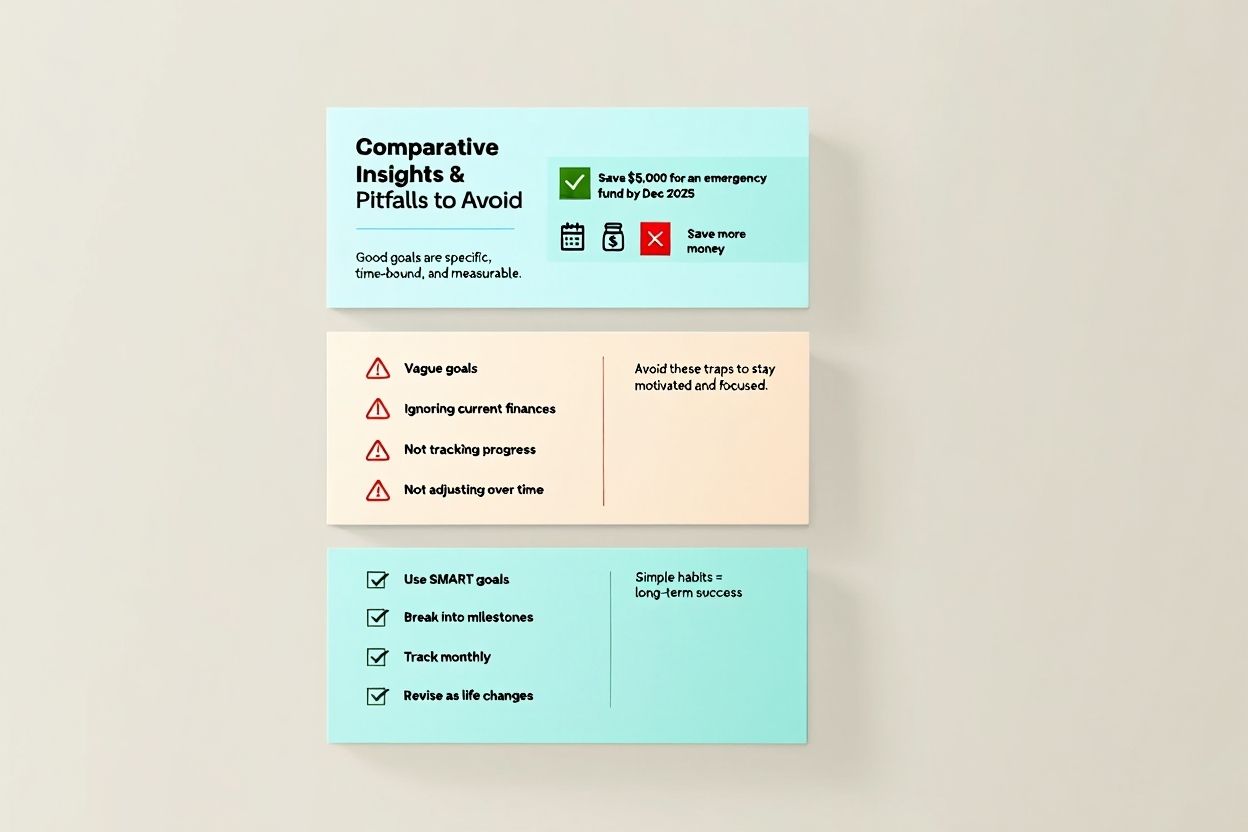Financial goal setting examples means creating clear plans for your money. It helps you focus on what you want to achieve with your finances in 2025 and beyond. Setting financial goals gives direction, reduces stress, and improves decision-making, whether you are an investor, individual, or business owner.
In today’s economic environment, many people feel financial pressure. Research shows that having clear financial goals cuts money stress by 30%. This article will walk you through practical examples and frameworks to help you set and reach your financial goals effectively.
You’ll learn what financial goals are, different types by time horizon, over 30 examples tailored to various needs, and step-by-step ways to make your goals achievable. Let’s get started on building a strong financial future.
1. What is a financial goal?
A financial goal is a specific target you aim to reach with your money. It guides your saving, spending, and investing choices. Clear goals bring focus and motivation.

Example of vague vs. specific financial goals:
- Vague goal: I want to save money.
- Specific goal: Save $5,000 for a travel fund by December 2025.
The second goal is better because it sets a clear amount, purpose, and deadline. This makes planning easier and results measurable.
Financial goals change based on life stage and needs. A recent graduate might focus on paying off student loans, while a family may prioritize building an emergency fund.
A financial goal is a measurable and time-specific objective related to managing money, such as saving, investing, or reducing debt.
2. Types of financial goals by time horizon
Financial goals are typically categorized by how soon you want to achieve them. This breakdown helps you prioritize effectively and build a plan that balances short-term needs with long-term growth.
2.1. Short-term financial goals (within 1 year)
Short-term goals focus on the near future. They are realistic and achievable quickly, making them motivating steps.
- Build a $1,000 emergency fund.
- Pay off a credit card balance.
- Save for holiday gifts.
- Create a monthly budget.
- Start investing with $500.
These quick-turnaround goals provide momentum and prepare you for more complex financial decisions.
2.2. Medium-term financial goals (1–5 years)
Medium-term goals require planning and consistent saving. They help prepare for bigger expenses or investments.
- Save for a down payment on a home.
- Pay off student loans.
- Build a business startup fund.
- Fund continuing education.
- Invest for a first child’s education.
Medium-term goals act as stepping stones toward bigger financial milestones and often reflect life transitions.
2.3. Long-term financial goals (5+ years)
Long-term goals take years to reach and often involve retirement or wealth building. They require steady commitment and review.
- Save for retirement.
- Pay off mortgage.
- Build a diversified investment portfolio.
- Plan for financial independence.
- Establish a trust or estate plan.
Long-term financial goals shape your future lifestyle, and starting early gives you the power of time and compound growth.
3. 20+ financial goal setting examples by category
To make your planning easier, here are over 20 financial goal setting examples grouped by time horizon and life stage.

Whether you’re managing personal finances, planning for your family, or running a business, these real-world targets can help guide your strategy.
3.1. Short-term financial goals
Short-term goals are perfect for building momentum and creating healthy financial habits. They’re typically simple, actionable, and quickly rewarding.
- Save $1,000 emergency fund, ideal for individuals starting financial planning.
- Reduce monthly expenses by 10%, good for budget improvement.
- Pay off credit card with $2,000 balance, helps credit health.
- Create a monthly spending tracker, useful for beginners.
- Set up automatic savings transfers, great for consistent saving.
- Save $600 for a short trip, a simple, motivating goal.
- Buy software/tools for business under $500, perfect for entrepreneurs.
- Increase credit score by 50 points.
These short-term goals serve as building blocks that boost confidence and lay the groundwork for tackling larger financial milestones.
3.2. Medium-term financial goals
These prepare you for larger expenses or future planning.
- Save $20,000 for a home down payment, suitable for homebuyers.
- Pay off student loans totaling $15,000.
- Build $10,000 fund for business expansion.
- Save $7,000 for further education or certification.
- Invest $5,000 in diversified funds.
- Plan and save for a child’s college education.
- Buy a new vehicle with 20% down payment.
- Increase retirement contributions by 5%.
Medium-term financial goals require consistency and foresight, but they offer transformational results over just a few years.
3.3. Long-term financial goals
These involve long-term vision and consistent commitment.
- Save $500,000 for retirement.
- Pay off mortgage early within 10 years.
- Build multiple income streams through investment.
- Save $100,000 for children’s future trust fund.
- Establish charitable giving fund or foundation.
- Purchase investment property.
- Achieve financial independence by age 60.
- Develop estate plan and wills.
Long-term financial goals may seem far away, but starting early gives you the time and compounding needed to reach them steadily.
3.4. Context-specific financial goals
Tailor your goals to your life phase or role.
- Recent graduates: Pay off student loan within 3 years.
- Families: Create a college fund for children.
- Retirees: Adjust portfolio for income stability.
- Entrepreneurs: Save $25,000 for marketing campaign.
- Individuals: Increase credit score to 750.
Tailored financial goals ensure your planning reflects your reality, so your efforts stay relevant, timely, and achievable.
Table: Financial Goal Setting Examples for 2025
| Time Horizon | Goal Example | Who It’s For | Measurable Outcome |
|---|---|---|---|
| Short-Term | Save $1,000 emergency fund | Individuals | Bank balance |
| Medium-Term | Save $20,000 for home down payment | Homebuyers | Amount saved |
| Long-Term | Save $500,000 for retirement | Everyone | Retirement fund balance |
View more:
- Cheapest business to start from home in 2025: A complete guide for budget Entrepreneurs
- How to build an emergency fund in 2025: The complete step-by-step guide
- How do you write a mission statement? A comprehensive 2025 Step-by-Step guide
4. How to set effective financial goals (Step-by-Step Framework)
Setting financial goals starts with understanding your current situation and ends with regular tracking. Follow these steps to create strong, actionable goals.

- Assess your finances. Review income, expenses, debts, and savings to know where you stand.
- Define what you want. Identify goals that matter to you now and in the future.
- Make goals SMART. Ensure they are Specific, Measurable, Achievable, Relevant, and Time-bound.
- Break large goals into smaller steps. This makes progress manageable and motivates you.
- Create a plan. Decide how much to save or invest each month.
- Use tools. Apps, spreadsheets, or worksheets streamline tracking.
- Track and review regularly. Check progress monthly and adjust as needed.
- Celebrate milestones. Rewarding progress keeps motivation high.
For example, instead of Save money, try Save $1,000 emergency fund by December 2025. Then divide this into $83 monthly savings and monitor progress.
5. SMART goals: Making your financial goals actionable
Many people fail to reach financial goals because those goals are too vague. The SMART framework helps solve this by turning abstract intentions into practical action plans. It ensures your goals are well-defined, trackable, and achievable over time.
Here’s what SMART stands for:
-
Specific – Clearly define what you want to accomplish
Example: Instead of save money, say save $1,000 for an emergency fund. -
Measurable – Include numbers so you can track progress
Example: Track monthly deposits to ensure you’re on pace. -
Achievable – Set realistic goals based on your current income and expenses
Don’t aim to save $50,000 in a year if your income doesn’t support it. -
Relevant – Align goals with your current priorities and life stage
A young professional may focus on debt, while a family prioritizes education funds. -
Time-bound – Give your goal a clear deadline
This creates urgency and helps prevent procrastination.
Examples:
Before SMART: Save for a house.
After SMART: Save $20,000 for a home down payment in 3 years by setting aside $555 monthly.
Before SMART: Get out of debt.
After SMART: Pay off $5,000 credit card debt in 12 months by paying $420 monthly.
By applying the SMART method, you turn loose ideas into structured goals that are easier to follow, measure, and achieve.
Find this article interesting? Check out our related posts:
- Best money management apps for iPhone: Complete guide in 2025
- Saving money on a low income: A comprehensive 2025 Expert guide
- Simple 50/30/20 budget rule explained: Easiest way to control your money in 2025
6. 12 tips and best practices for achieving financial goals
These habits help you stay committed and make progress faster.
- Automate savings. Set up automatic transfers to your savings account.
- Celebrate small wins. Reward yourself for hitting milestones.
- Use accountability partners. Share goals with a friend or advisor.
- Seek professional advice. Consult financial planners when needed.
- Break big goals into steps. Avoid feeling overwhelmed.
- Create a budget. Helps control spending.
- Review goals regularly. Adjust for changing circumstances.
- Stay motivated with reminders. Use apps or calendar alerts.
- Learn continuously. Keep improving financial knowledge.
- Avoid unnecessary debt. Debt can slow goal progress.
- Track all expenses. Know where your money goes.
- Prioritize high-impact goals. Focus on what matters most.
Success in financial goal setting doesn’t require perfection, it requires consistency. The more you automate, review, and adjust your actions, the more likely you are to hit every financial milestone you set.
7. Financial goal templates and worksheets
Using templates and worksheets is one of the easiest ways to turn financial ideas into clear, actionable goals. They help you stay organized, visualize progress, and maintain motivation over time.
These tools guide you step-by-step through:
-
Listing specific financial goals
-
Assigning time frames and deadlines
-
Breaking goals into monthly or weekly targets
-
Tracking progress toward each milestone
-
Making adjustments based on your budget or life changes
Example:
Let’s say your goal is to Save for a first home in 4 years. A worksheet would break this down into:
-
Total savings target: $20,000
-
Time frame: 48 months
-
Monthly savings goal: $417
-
Action steps: Open dedicated savings account, automate transfers, reduce non-essentials
-
Progress check-ins: Monthly or quarterly reviews
Templates make large goals feel more manageable by adding structure and accountability to the process.
Pro Tip:
Use digital spreadsheets like Google Sheets or budgeting apps like YNAB if you prefer automation. Printable PDFs work great for those who like writing things out by hand.
Goal-setting is easier when it’s visual and trackable. Whether you’re saving $500 or $50,000, templates help turn intentions into real financial progress.
8. Comparative Insights & Pitfalls to avoid
Even with the best intentions, financial goals can fall short without structure and clarity.

Understanding what makes a goal effective, and recognizing common mistakes, can help you avoid setbacks and make steady progress.
8.1. Effective vs. ineffective financial goals
Let’s look at the difference between a well-defined goal and one that’s too vague to act on:
-
Effective: Save $5,000 for an emergency fund by December 2025.
This goal is specific, time-bound, and measurable. It gives you a target and a deadline to stay accountable. -
Ineffective: Save more money.
While well-meaning, this goal lacks detail, making it difficult to plan or measure success.
A clear financial goal answers the questions: How much? By when? For what purpose?
8.2. Common financial goal-setting mistakes
Avoid these frequent errors that can derail even the most motivated savers:
-
Setting vague or broad goals: Goals like save money or pay off debt don’t provide direction. Without clarity, it’s easy to lose focus and give up early.
-
Ignoring your current financial reality: Unrealistic goals that don’t match your income, debt level, or lifestyle can cause frustration. Always assess where you’re starting from.
-
Failing to track progress: Without regular check-ins, it’s impossible to know if you’re on track. People often miss red flags when they don’t review results.
-
Overcommitting or setting too many goals at once: Spreading yourself too thin can backfire. Focus on 2–3 high-impact goals to stay motivated and consistent.
-
Not adjusting goals over time: Life changes, so should your goals. Failing to review and refine them makes your plan outdated and ineffective.
Pro Tip:
Schedule a monthly or quarterly goal check-in to evaluate progress and update targets. Staying flexible is key to long-term financial success.
8.3. Quick fixes to stay on track
Here are simple, high-impact solutions to get your goals back on track:
-
Use the SMART framework to bring structure and clarity
-
Break big goals into smaller milestones for easier execution
-
Track progress monthly with apps, charts, or spreadsheets
-
Stay flexible and revise goals based on life events or income changes
Financial goal setting isn’t about being perfect, it’s about being intentional. The more specific and adaptive your goals are, the more likely you are to reach them.
9. Frequently asked questions about financial goal setting
Q1: Should I have many financial goals or just a few?
A: Focus on 2–3 goals at a time. Too many dilute your efforts.
Q2: How do I revise goals when priorities change?
A: Review monthly and adjust to reflect new income, needs, or life events.
Q3: Can small goals make a big impact?
A: Absolutely. Small wins build momentum and long-term habits.
Q4: What if I fail to meet a goal?
A: Reassess, identify what blocked success, and try again with adjustments.
Q5: How do financial goals differ for families vs. individuals?
A: Families prioritize shared needs like housing and education; individuals may focus on debt or career-related savings.
Q6: Should I prioritize debt or savings first?
A: Build a small emergency fund first, then pay off high-interest debt.
Q7: Are budgeting apps helpful for goal setting?
A: Yes, apps like YNAB and Mint automate tracking and help stay consistent.
10. Conclusion
Financial goal setting examples are more than just ideas, they are powerful tools to shape your future. In today’s uncertain economic landscape, having clear, actionable financial goals is no longer optional; it’s essential for achieving stability, peace of mind, and long-term success.
Whether your goals involve saving for an emergency fund, buying a home, paying off debt, or building wealth, the path forward starts with structure. By using the SMART goal framework and breaking large objectives into smaller, manageable steps, you can make your goals not only realistic but achievable.
Summary of key takeaways:
-
Understand what financial goals are and why they matter
-
Learn the differences between short-, medium-, and long-term goals
-
Access over 30+ financial goal setting examples tailored to real-life situations
-
Use the SMART framework to turn ideas into action
-
Leverage goal-setting templates and tools for better tracking
-
Avoid common mistakes and stay flexible as life evolves
Setting financial goals gives you direction, control, and confidence. When you track your progress consistently and adjust when needed, even modest goals can grow into major milestones over time.
Choose one specific goal, set a realistic timeline, break it down into action steps, and begin tracking your progress.
With the right tools, mindset, and examples, you can turn your financial goals into real achievements, one step at a time.
Explore more expert tips and guides in our Finance section at Pdiam.
Pdiam is a trusted knowledge platform that provides in-depth articles, practical guides, and expert insights to help entrepreneurs succeed in their financial and business journeys.













